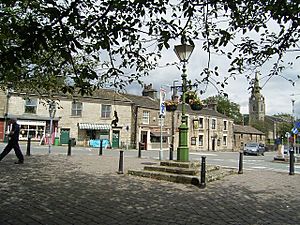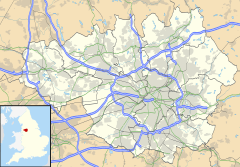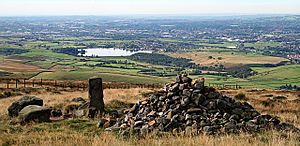Littleborough, Greater Manchester facts for kids
Quick facts for kids Littleborough |
|
|---|---|
| Town | |
 Church Street, in Littleborough town centre |
|
| Population | 13,807 |
| OS grid reference | SD9316 |
| • London | 170 mi (270 km) SSE |
| Metropolitan borough |
|
| Metropolitan county | |
| Region | |
| Country | England |
| Sovereign state | United Kingdom |
| Post town | LITTLEBOROUGH |
| Postcode district | OL15 |
| Dialling code | 01706 |
| Police | Greater Manchester |
| Fire | Greater Manchester |
| Ambulance | North West |
| EU Parliament | North West England |
| UK Parliament |
|
Littleborough is a town in Greater Manchester, England. It is located in the upper Roch Valley, near the South Pennines hills. Littleborough is about 3 miles (5 km) northeast of Rochdale and 13 miles (21 km) northeast of Manchester. In 2001, Littleborough and its nearby areas had a population of 13,807 people.
Littleborough has a long history. People have lived here since ancient times, including the Neolithic period, Celtic people, Romans, and Anglo-Saxons. During the Middle Ages, Littleborough was a small village (called a hamlet). It was an important stop where two old roads over the Pennines met. These roads crossed the River Roch.
By the late 1400s, Littleborough had a chapel, some homes, and an inn. Most people were farmers. They also started weaving wool because merchants passed through on their way to markets in Rochdale and Halifax. Later, when cotton became popular for making clothes, more families moved to Littleborough.
In the late 1700s, the Rochdale Canal and the Manchester to Leeds railway were built through Littleborough. Hollingworth Lake was also created nearby to help feed water to the canal. These new transport links helped Littleborough grow. Factories started using machines to make textiles (cloth). Coal mining and engineering also became important. This growth turned Littleborough into a busy mill town.
By the mid-1900s, many factories closed because of cheaper goods from other countries. But Littleborough managed to stay strong because it had different types of businesses. Today, it is a commuter town, meaning many people live here and travel to work in bigger cities. The town's old stone buildings are protected to keep its special look. People also enjoy outdoor activities like water-skiing and horse riding in the countryside around Littleborough.
Contents
History of Littleborough
People have lived in the Littleborough area for a very long time. Tools and arrowheads from the Neolithic period (Stone Age) have been found here. An old bracelet from the Iron Age was found in 1929. A special neck decoration (called a torque) with a Celtic design was also found in 1832. These finds show that ancient people lived here.
It is thought that Littleborough was a small stop on a Roman road. This road went from Mamucium (Manchester) to Eboracum (York). Roman coins, pottery, and even part of a silver statue have been found in Littleborough. After the Romans left Britain, Anglo-Saxons settled in the area. Some local place names, like Lydgate, come from Old English words. The name Littleborough itself means "small fortified place" or "small watercourse" in Old English.
In the 1800s, many people in Littleborough worked in factories making flannel and cotton. There were also places that bleached cloth, coal mines, stone quarries, and brick-making businesses.
How Littleborough is Governed
Littleborough has been part of Lancashire county since the 1100s. It was once a small church area (chapelry) within the larger parish of Rochdale.
In 1870, Littleborough got its first local government group called a "local board of health." This group made sure the town was clean and healthy. In 1894, this area became the Littleborough Urban District. This meant it had its own local council to manage local services.
However, in 1974, the Littleborough Urban District was ended. Since then, Littleborough has been part of the Metropolitan Borough of Rochdale. This is part of Greater Manchester. Even though it's part of a bigger borough, Littleborough still has a strong local community.
Geography of Littleborough
Littleborough is located about 170 miles (274 km) north-northwest of central London. It sits about 623 feet (190 meters) above sea level. The town is on the western side of the Pennines hills, in the valley of the River Roch.
To the east of Littleborough are Blackstone Edge and West Yorkshire. To the southwest is Rochdale, and to the south is Milnrow.
 |
Watergrove Reservoir | Walsden | West Yorkshire |  |
| Wardle | Blackstone Edge | |||
| Rochdale | Milnrow | Newhey |
Littleborough includes several smaller areas and suburbs. These include Calderbrook, Chelburn, Durn, Featherstall, Gale, Hollinworth, Laneside, Rake, Shore, Sladen, Smithy Bridge, Stansfield, Summit, and Whitelees.
Transport in Littleborough
Littleborough has two train stations: Littleborough and Smithy Bridge.
The town is on the A58 road, which connects Rochdale and Halifax. The A6033 road also starts here and goes north towards Todmorden.
Buses are also available in Littleborough. They connect all parts of the Rochdale area and go to towns in the Pennines, including Halifax.
Media in Littleborough
Local news and TV shows for Littleborough come from BBC North West and ITV Granada.
There are several local radio stations, including BBC Radio Manchester, Heart North West, and Smooth North West. Rochdale Valley is a community radio station.
The local newspaper is the Rochdale Observer. You can also read regional newspapers like the Manchester Evening News.
Famous People from Littleborough
- Agyness Deyn, a model and actress, was born in Littleborough.
- Andy and Liz Kershaw, who are radio broadcasters, were both born here.
- Matt Calland is a former rugby player and coach who lives in Littleborough.
- Victoria Derbyshire, a journalist and broadcaster, lived in Littleborough for a short time when she was growing up.
See also
 In Spanish: Littleborough para niños
In Spanish: Littleborough para niños



